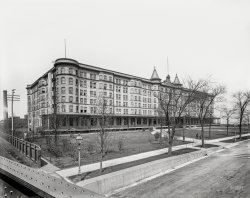
MAY CONTAIN NUTS

Search Shorpy
SHORPY ART

Framed or unframed, desk size to sofa size, printed by us in Arizona and Alabama since 2007. Explore now.
Join and Share
Ad-Free Shorpy
Shorpy is funded by you. Patreon contributors get an ad-free experience.
Learn more.

Recent comments
- Yellow sky at morning
- Side Winder
- Air Quality?
- Sojourner Truth riot
- None were so blind(ed)
- The less famous sister
- Good ol' days?
- Rise and Fall
- Goo Goo Ga Joob
- Ticket Retention
- Not the only one
- Vagaries of War
- Killed by Amtrak
- Back to the Future
- Wanted --
- If you can't stand the light
- Centralized Traffic Control, I believe
- What's really happening
- Heckuva remote control!
- Sometimes — Things Go Bump!
- I SEE THE LIGHT
- Union Switch and Signal Company
- Get That Light Out Of My Eyes
- Eggs. Eggs. Eggs. The Egg Man is Here!
- Foreboding caption
- Famous Hollywood faces
- Not just S&P
- re: Those things in the jar
- Up In Smoke
- Medical Smoking
Member Photos
The Shorpy
Print Emporium
Print Emporium
Search Shorpy
Search results -- 30 results per page
- On Walden Pond: 1937
- ... dog stands and old beer cans. In the name of recreation, trees were felled on the eastern shore to make an addition to the present beach ... Posted by Dave - 06/14/2008 - 11:31am -
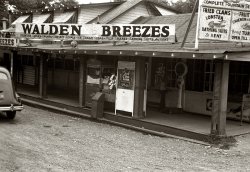
- Avenue Grand: 1920
- ... the elaborate brickwork on the right (seen through the trees) is still there, now a liquor store.
View Larger Map
... Posted by Dave - 09/12/2011 - 1:10pm -
![Avenue Grand: 1920 Washington circa 1920. "Crandall's Avenue Grand," 645 Pennsylvania Avenue S.E. Now playing: "Dangerous to Men." National Photo Co. View full size.
Dr. JJohn Barrymore in "Dr Jekyll & Mrs Hyde." I think I would enjoy that very much. There's so little to see in the movie theatres these days, except at Oscar time. I'm not a great fan of animation. It's not cinema, it's cartoons.
Avenue Grand
The Avenue Grand
8 Big Acts Each Week
Pictures - Vaudeville
645 Pa. Ave S.E.
Doors Open at 6:30 P.M.
Washington Post, Sep 17, 1910
Buys the Avenue Grand
Crandall Acquires Picture House in Pennsylvania Avenue
Henry M. Crandall, one of Washington's pioneer motion picture exhibitors, has acquired the Avenue Grand motion picture establishment, in Pennsylvania avenue, between Sixth and seventh streets southeast, and will reopen the theater in about two weeks.
The Avenue Grand is known as the largest motion picture theater here in a residential district. It has a seating capacity of more than 1,000, and is equipped with a balcony and a stage for straight theatrical productions.
Washington Post, Mar 26, 1916
Crandall's Avenue Grand Reopens
The reopening of the Avenue Grand under the management of Harry M. Crandall was welcomed by capacity audiences at all performances yesterday and Sunday. The theater has been thoroughly renovated and redecorated, and a gold screen and an efficient ventilation system has been installed. ...
Washington Post, Apr 18, 1916
Viola Dana and Milton SillsHer career ended in 1929 when sound movies began; probably no coincidence. She died in 1987 at age 90. He survived the advent of sound but not his heart attack at age 48 in 1930.
Dangerous to MenHey, they made a movie about the Drexel Women's Rifle Team!
Old Movies for NewWhat's interesting is that while "Dangerous to Men" premiered in 1920, "Old Wives for New" came out in 1918. I wonder why it was showing a movie that had premiered two years prior?
[Second-run showings are nothing new. - Dave]
The shadow manDid anyone notice the shadowy guy in front of M.B. Flynn's Stoves?
J. MuttsThe theater is gone, but the building with the elaborate brickwork on the right (seen through the trees) is still there, now a liquor store.
View Larger Map
Capitol HillRobert K. Headley's "Motion Picture Exhibition in Washington, D.C." has this info about the fate of the Avenue Grand: It was renamed the Capitol Hill between 1956 and 1970. Don King operated it in the sixties, refurbishing it in 1967, with unrealized plans to make it a cinematheque where patrons could eat. A fire in November 1970 gutted the building, and it was razed soon after.
(The Gallery, D.C., Movies, Natl Photo)](https://www.shorpy.com/files/images/29196u.thumbnail.jpg)
- Bell, Bark and Saddle: 1939
- ... trunk.
Like sycamore, the outer bark peels off as those trees grow.
Antenna I would have guessed a 20m Dipole antenna. That, ... Posted by Dave - 01/02/2018 - 10:50pm -
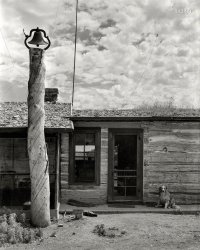
- The Clothesline Kid: 1939
- ... snapped in July due to the distinct lack of foliage on the trees.
Row house? I don't think these are "row houses" but rather the ... Posted by Dave - 04/23/2013 - 10:18am -
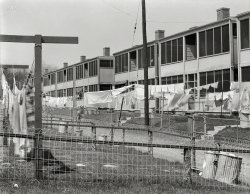
- Irving Place: 1905
- ... of the big ugly box of a building across the street, the trees and removal of the ivy is beautiful.
View Larger Map
... Posted by Dave - 08/21/2012 - 12:38pm -
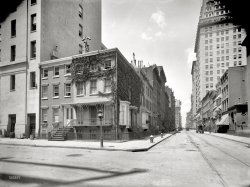
- Beaucoup Bridges: 1938
- ... give me the same angle as Mr. Rothstein's photograph; but trees, foliage, and high guard rails block the view he had. ... Posted by Dave - 09/10/2020 - 9:38am -
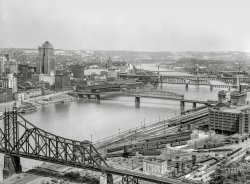
- The Bossy Lamppost: 1943
- ... Florida closet now.
Season ? With all the leafless trees and heavy clothing it's not likely a May-June scene.
Traffic? What ... Posted by Dave - 01/31/2013 - 4:18am -
![The Bossy Lamppost: 1943 New York, May-June 1943. "Many accidents are attributed to unpatrolled intersections in Harlem. Here schoolchildren are allowed to run across busy intersections unescorted." Photo by Gordon Parks for the OWI. View full size.
Ashcan Alley nearby?The Ashcan Alley post had a can that seemed to have "4ST" painted on it. Given this was in Harlem, I had wondered if that meant 134th Street.
Since the Bossy Lamppost shows Gordon Parks was shooting on 134th, I bet the Ashcan Alley is nearby. Could not find it, though, on Google Street View.
[134th is the cross street. As noted below by timeandagain, we are looking north up Seventh Avenue. - Dave]
7th Ave. todayThis view is looking north on Seventh Avenue (now Adam Clayton Powell Jr. Boulevard) from W. 134th Street.
View Larger Map
Quiet SchoolAs a 29 year teacher, I don't think I've ever been to a Quiet School.
A historic spot for a crossingOne street up, on the left, is The Big Apple, a bar and club opened in 1934, it was frequented by musicians and entertainers. Bessie Smith was there several times. Opposite it was a more famous club, Smalls' Paradise, which was eventually bought by Wilt Chamberlain. In the 1960s, it was openly a gay bar, but it had almost been that since the 1930,when it was a showbiz hangout.
The upside-down apple sign was a landmark of sorts. Someone rescued it and put it up on eBay, but too much money was asked. It is rumored to be in someone's Florida closet now.
Season ?With all the leafless trees and heavy clothing it's not likely a May-June scene.
Traffic?What traffic?
Looks kind of quiet on the road. So the kids probaly had a viable excuse. And the whole lot looks rather orderly. So I wonder whether there is not somebody "qualified" in the lead, masked by the lamppost, even there is nobody bringing up the rear.
I wonder, too, how I survived my own childhood. No bicycle helmets, roaming around on my own, walking to school unattended (even to pre-school), and so on.
(The Gallery, Gordon Parks, Kids, NYC)](https://www.shorpy.com/files/images/SHORPY_8d28510a.thumbnail.jpg)
- Where's Waldo: 1964
- ... the Google street view from the overpass matches; those trees in the '64 shot have now grown so you can't see the tunnel from there. ... Posted by tterrace - 09/23/2011 - 1:48am -
![Where's Waldo: 1964 October 1964. U.S. 101 above Sausalito, Calif., the Waldo Grade approach to the Golden Gate Bridge. Similarities after 44 years: same number of traffic lanes. Differences after 44 years: many more cars, but none of them have fins. My color slide with Montgomery Ward brand film. View full size.
Chrysler or DeSotoCan you blow up that gray car on the left? At first I thought 1961 Chrysler but it looks a little like it has the 61 DeSoto's weird oval upper grille.
[I was wondering the same thing. - Dave]
TailfinsAbout 7½ years earlier you might have caught our brand-new, highly-finned, White-over-Turquoise '57 Chevy Bel Air along there as we trekked to SF from Novato to show Golden Gate Park etc. to my maternal grandmother visiting from Australia. It seemed that half of the time the GG Bridge
towers were enshrouded in fog!
Yep, a DeSotoChryslers didn't have that pattern of two-tone (sides one color, top different).
[If I may interject: There's no two-toning on that car. And I'm pretty sure there were no 1961 DeSotos with the two-tone paint scheme you describe, either. - Dave]
I should be able to identify the first car on the left, but I'm not sure -- the strake-fold above the rear wheels should be distinctive. After that:
The aforesaid Desoto;
Black '57 Chevy Nomad;
VW Karmann Ghia convertible;
'63 Chrysler;
Pre-1950 Ford pickup;
Another black '57 Chevy, this one a sedan;
'52 or '53 Mercury.
The black blob just before the curve is unidentifiable, at least by me.
Going the other way:
The blue pickup under the lamppost -- ??
Red '59 Chevy El Camino -- if you had that car now, you could sell it and buy a house;
The others I can't do. I think the white car on the right is a brand-new Pontiac Le Mans.
Regards,
Ric
Point Of Viewtterrace, were you standing on the Wolfback Ridge overpass when you took this?
Waldo viewpointYep, the Google street view from the overpass matches; those trees in the '64 shot have now grown so you can't see the tunnel from there. BTW, I remember when that southbound bore was the only one, with both directions, four lanes undivided, going through. An exciting ride, especially on rainy winter nights. And noisy because those were the days when you were expected to violate the no-horn-blowing-in-tunnels stricture. Sometimes I even could pester my father into a beep or two.
Fifty-NinerNoticed the '59 El Camino right away. I owned one for about four years but had to sell it in 2005. Dang I miss that thing. Nice Photo!
(ShorpyBlog, Member Gallery, Cars, Trucks, Buses, tterrapix)](https://www.shorpy.com/files/images/waldo.thumbnail.jpg)
- Scout Kar: 1918
- ... which suggests nothing except the surrounding earth, trees, grain fields, sky, etc., making an exact fac-simile of the cars now ... View full size.
What car? All I see is a bunch of Trees.
October 28, 1917 Slow news day in Oakland.
Word of the day: ... Posted by Dave - 11/11/2014 - 7:38pm -
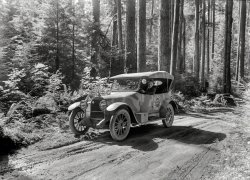
- Gamble's Clipper: 1940
- ... on the pillar at right. Obviously, no living trees were around to mutilate, so lover-boy had to make do with this porch ... Posted by Dave - 11/21/2011 - 1:52am -
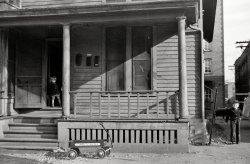
- On Broadway: 1903
- ... only odd monument Visible at the left edge through the trees of Madison Square Park is the 1876 statute of William H. Seward by ... Posted by Dave - 11/02/2013 - 3:03pm -
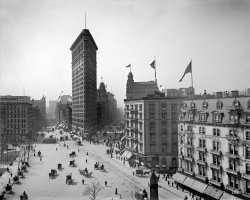
- Nash Wash: 1955
- ... It does look more like summer with the full leaves on the trees.
(ShorpyBlog, Member Gallery) ... Posted by AAAndrew - 10/05/2014 - 4:53pm -

- Danger Lurks: 1908
- ... America. Points of interest in this 8x10 glass plate: many trees camouflaging one ambush. Bain News Service. View full size.
Cos ... Posted by Dave - 10/27/2019 - 3:24pm -
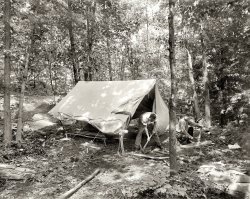
- Texas Gothic: 1939
- ... a motel nearby?
Check out time Apparently, the trees are leafing the mansion.
I wonder There is some lettering above ... Posted by Dave - 06/02/2018 - 10:51am -
![Texas Gothic: 1939 November 1939. "Old mansion in Comanche, Texas." Boo, y'all! Medium format negative by Russell Lee for the Farm Security Administration. View full size.
Oakland HeightsAs a native of Comanche, Texas, I can say for certain that the house was named Oakland Heights, and was built before 1887 by a man named Dexter Walcott. (The street which ran in front of the house is still named Walcott Avenue.) A man named F. M. Browne added the Victorian decorations and additional stories a few years after. It stood on one of the tallest points in the town, befitting its name. The house was a showpiece in its early years, but fell into ruin as the family died out. (By the time of this photo, it may have been already vacant.) It was torn down as a derelict in the 1950s and replaced by a ranch-style home which stands on the site today, using the original house's foundation.
Oakland Heights also served as the model for the cover of Richard Brautigan's novel "The Hawkline Monster," according to cover artist Wendell Minor.
DetailsA lot of gingerbread on this house. And the brickwork on the chimney is fantastic!
Vacation plansIs there perhaps a motel nearby?
Check out timeApparently, the trees are leafing the mansion.
I wonderThere is some lettering above the entrance on the far right. Any chance of seeing a closeup?
[OAKLAND HEIGHTS, maybe. Or OAKLAWN. - Dave]
I recognize the house!This is the Texas residence known as the old Addams place. Inhabited by a family of very exotic yet loving souls, it’s their southern vacation villa for use in hurricane season. Pan-dimensional, all of the windows face south to take advantage of looming storms.
Room with a viewI want to be in that fourth-story cupola, sitting in a swivel chair.
(The Gallery, Russell Lee)](https://www.shorpy.com/files/images/SHORPY-8b38123a1.thumbnail.jpg)
- Needle's Eye: 1943
- ... messaging. On the other side of F Street, where the palm trees are is Santa Fe Park, which is in front of El Garces Hotel (Harvey House). There aren't as many palm trees today.
We cross Front Street as it jogs around Santa Fe Park. Here we ... Posted by Dave - 03/01/2014 - 10:14am -
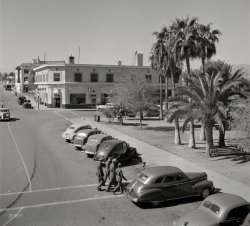
- Fiesta Bawl: 1940
- ... are still Basque names carved into the white bark of aspen trees on the San Francisco peaks in Northern Arizona and I've had some ... Posted by Ken - 09/08/2011 - 8:37pm -
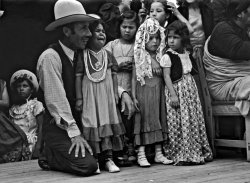
- Road Tripping: 1952
- ... of Eureka Springs also would make sense given the way the trees have turned more in this picture.
[What about "O. Wiltfong" -- are ... Posted by Dave - 09/02/2014 - 3:09pm -
![Road Tripping: 1952 "6 Oct 1952. Clara & Grace at chenille & souvenir shop south of _______ ." We're back with Hubert and Grace on their road trip from Minnesota, the day before our previous photo was made at Eureka Springs, Arkansas. Where are we now? 35mm Kodachrome by Hubert Tuttle; paint by Dr. Seuss. View full size.
JCT ASince the Missouri DOT doesn't have money to pave roads anymore, they have lots of time to do things like scan all of the old state highway maps. The '48/'49 and '53 maps confirm that there was never a Route T near Phillipsburg. In '49, Route T went all the way from Montreal (Missouri) to Route 66, but by '53, part of it was replaced by Missouri 35. The south end of that Route T being in Laclede County precludes there being another Route T in Laclede County that isn't connected to it.
My further guess would be that this is between Phillipsburg and Lebanon, because 1) the shadows say we are looking more or less north and 2) we can see the *backs* of signs that are advertising the wonders to be found to the south.
I spent a little time with Google Street View looking for that hill, but nothing jumped out at me. It's possible that the hill was eased when I-44 went through - the interstate would be pretty much right where Clara and Grace are standing.
How About This?Back then, the way to get from Minnesota to Eureka Springs, Arkansas was along Highway 65. Given that people in 1952 didn't travel as far in a day as we do, I'm going to guess this is around Sedalia, Missouri.
Not as rare a name as I thoughtI had thought that Wiltfong was a very rare name that might provide a location clue, but an online search shows well over 100 people with that surname. While they're located all over the place, there are a number in Missouri, which ties in with a prior comment. Someplace to the north of Eureka Springs also would make sense given the way the trees have turned more in this picture.
[What about "O. Wiltfong" -- are there hundreds of them? -Dave]
[Edit: No O's that I could find. Probably wouldn't matter, as the O in this picture has likely been long since gathered to his/her ancestors.]
[It does matter, if you're trying to figure out where this is. - Dave]
Country Roads Back when I was a lad, American highway lanes were separated by a white line (broken or solid as appropriate), as shown here. Somewhere along the line, the white of those lines was replaced with yellow, and white was retained only for separating same-direction lanes on multiple-lane roads. Apparently this was a change I completely slept through, because I can't place the time when it took place.
I wonder if anyone out there can pinpoint when this change occurred. The reason I'd like to know is that I find it irksome when "period" movies show yellow lines on putatively vintage roads (much like showing red/blue mailboxes in an era when they should be green), and I'd like to know at what portrayed period I can relax in this regard and, therefore, not feel an oppressing need to get a life.
[That bugs me in period movies, too. The change from white to yellow began in 1971 when the Federal Highway Administration assumed responsibility for the Manual on Uniform Traffic Control Devices. Everything you ever wanted to know about it is in this document. -tterrace]
I know where they are. Just outside of Hooterville.
Oliver!Oliver Wiltfong, born in 1900, was living in Blue Springs, Missouri, in 1920. In 1940, he was in St. Louis. Perhaps Ollie ended up at this roadside oddity by the time this pic was taken.
Route 66 Novelty MerchantThis is probably the home/business of Novelty Merchant Oliver U. Wiltfong in rural Lebanon area of Missouri.
Oliver (and wife Jessie) lived in rural Lebanon, Laclede County, Missouri, for about 2 years prior to Oliver's death from brain cancer on May 6, 1949.
They resided near Phillipsburg, a village of about 200 population southwest of Lebanon along U.S. Route 66 (now I-44). Postal address: Phillipsburg Rt I.
Assuming Jessie remained living in Phillipsburg after Oliver's death, at the time this photo was taken in 1952 I would venture to say this is probably the family home on Route 66 near Phillipsburg.
During the 1940/50s is was customary for folks living along Route 66 to sell novelties from their yards to passing travelers.
[The old Route 66, now State Highway W, parallels I-44 near Lebanon, Missouri, the town whose name fills in the blank in our caption. Below is Oliver's death certificate; click to enlarge. His address is given as Phillipsburg Route T, presumably State Highway T in the vicinity of Phillipsburg. - Dave]
[Dave - *Missouri T* is north of Lebanon. It runs south from Stoutland, MO to old Route 66 where it ends. Hence my conclusion the address on the Death Certificate is a U.S. Post Office mailing address (not a highway route). It's doubtful *Missouri T* ever ran all the way down to Phillipsburg, MO (unless since the 1940/50s the State renamed all the highways).
Common sense says to me that since Oliver sold novelties he would locate on old Route 66 for maximum traveler traffic. Few travelers ventured off of Route 66 particularly in rural areas (except to visit major attractions).
The building in the photo appears to be an old barn or shed dressed up a bit as a novelty shop by adding a false front and roof over hang. Notice the arched front vs. the pitched metal roof on the building; and, the double swinging barn type doors at the front of the building.
During the early to late 1950s my family traveled Route 66 annually from California to Missouri on vacations to visit family living in Missouri. The highway shown in the photo is what Route 66 was like most of the way from Chicago to California - a two lane concrete and/or asphalt highway.
The mail box with the name *O. Wiltfong* on it leads me to believe this is the property where Oliver and Jessie lived on old Route 66; and, that they converted an out building to a novelty shop.
All of this leads me to believe the photo was taken at the Wiltfong residence (and novelty shop) on old Route 66 in Phillipsburg, MO southwest of Lebanon, MO. - SilverfoxCo ]
(Minnesota Kodachromes, Travel & Vacation)](https://www.shorpy.com/files/images/SHORPY-MNK360A.thumbnail.jpg)
- Arlington Beach: 1925
- ... isn't moving... You can see that the leaves on the trees are blurry with movement, but the people on the Ferris Wheel are nice and ... Posted by Dave - 09/13/2011 - 10:41am -
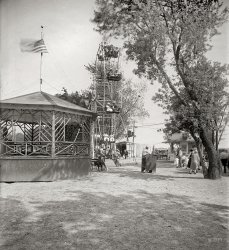
- Glen Echo: 1925
- ...
American Beer Garden The outdoor atmosphere, the trees and the picnic tables hark back to the German-American beer gardens that ... Posted by Dave - 08/24/2013 - 6:49pm -
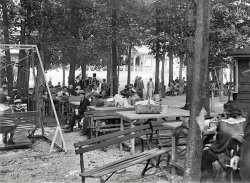
- Eat Apples: 1926
- ... Month .
A whole lot of apples... from those tiny trees!
A little later shot of that building I shot that building about ... Posted by Dave - 09/04/2012 - 4:00pm -
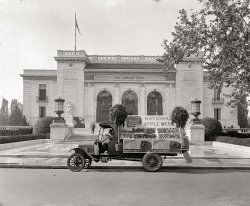
- Texas Tourists: 1920
- ... side of the car. Perfect for clearing the road of fallen trees I suppose.
Kid cage! "Throw the kids in the cage, Maw, it's time ... Posted by Dave - 04/22/2013 - 9:10am -
![Texas Tourists: 1920 Washington, D.C., or vicinity circa 1920. "Dr. A.A. Foster and family of Dallas, Texas." A second look at the auto-tourists seen here yesterday, and their modified Model T Ford. Harris & Ewing glass negative. View full size.
Not Just a CageThe cage walls are bed springs. I'd bet they either fold down for sleeping or detach to be set up as cots.
Cheap But Seldom CheerfulThe best feature of a Model T (aside from the admittedly low purchase price) was that almost anything one did to change it resulted in something better than that with which one started.
Tin-Can Tourists
Washington Post, August 21, 1921.
Washington Is the Mecca of Open Air Auto Tourist
Washington this season has been the mecca for the tin-can tourist. Where the tidal basin basks at night under the hush of the star-flecked sky, where the moonlight falls in soft spray on the banks of the Potomac, just east of the railroad bridge, the officials have designated a spot where the tin-can tourist may make his bed. There he is cushioned on tufted lawn far away from the hue and cry of the city, out of the canopy of heaven, but near enough at all times to be within reach of things that civilization demands. …
The main attraction to touring in this fashion, all the tourists agree, is that it gives opportunity to study the country, its peoples and their ways. … All agree that the West is where they find the greatest hospitality. The East is not yet ready for the open-air tourist.
For the most part, the tourists run well into age. That is, some of them are nearing the 80-year-old mark. Occasionally there are middle-aged couples, who have with them their children, and once in a while there is a young couple on their honeymoon. …
MomShe still looks just as thrilled.
[Waiting for someone to invent Four-Zone Climate Control. - Dave]
Axe mountI just wanted to point out the slick axe mount on the side of the car. Perfect for clearing the road of fallen trees I suppose.
Kid cage!"Throw the kids in the cage, Maw, it's time to shove off!"
Noting safer for the lil ones than a wire mesh matress-padded compartment for travel.
"With roll-down curtains, in case there's a change in the weather."
Pop Up CamperVery practical bed arrangement. The beds fold up to keep the kids on board during travel and fold down outside the camper to make beds at night. Similar to a modern day tent camper.
(The Gallery, Cars, Trucks, Buses, D.C., Dogs, Harris + Ewing, Kids)](https://www.shorpy.com/files/images/SHORPY_30236a.thumbnail.jpg)
- A Walk in the Woods: 1906
- ... I'm thinking at first glance that those are white birch trees from which the above titled soft drink used to be made on the East Coast. ... Posted by Dave - 07/29/2012 - 1:29pm -
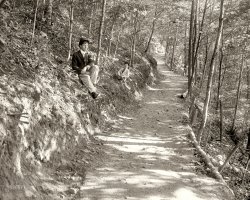
- Petworth: 1930
- ... from the image projected here. For one thing, the trees are now have had 80+ years to mature. But yes, it's a city, and yes, ... Posted by Dave - 03/18/2018 - 11:23am -
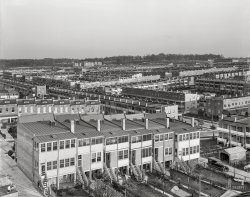
- Tank & Barrel: 1903
- ... 20th century. Southeast Texas provided its share of pine trees to the naval stores market, to the point that a town in Jasper County was ... Posted by Dave - 10/02/2016 - 5:59pm -
![Tank & Barrel: 1903 1903. "Plant of the Consolidated Naval Stores Company, Pensacola, Florida. Resin and turpentine." 8x10 inch dry plate glass negative. View full size.
WiredAny idea about the wires surrounding the tank? Lights? Lightning rods?
Where are the signs? There should be about 100 "No Smoking" signs plastered all over the site.
Wooden barrels (dry and aged, from appearance) filled with turpentine, or pitch, and heated in the sun and exuding all sorts of aromatics, the site is a fire hazard awaiting the match.
Given that Florida is the "Lightning Capital of the World", I would suspect the conductors are for lightning dissipation. If the array had been a bit closer, I would have thought it might make a Farady Cage, which would be an excellent lightning protector. As it is, circling the top, and repeating the circle down the side of the tank multiple times, there is a conductor to ground close at hand for lightning to connect with surrounding the tank. Only question I have is that the diameter of the wire is so small, and would likely vaporize if it had to pass common lightning amperage.
The lightning protection wires on a 100-year newer building(well, 90)in Atlanta at the 20th+ floor were almost the diameter of a large "Magic Marker" tube, a common office item for comparison. That shown appears to be common barbed wire, not the 'thumb size' of modern conductors.
Sacrificial barrels on storage barn It appears the half-dozen or so barrels on the peak of the roof of the building in the background are decoys for lightning. Here in GA, we have decoy trailer parks for tornadoes to scatter, leaving the real ones untouched. I suspect both work just as well at their task.
Roof BarrelsThose barrels on the ridge of the roof are water-filled, and very effective, immediate fire extinguishers. We saw these mounted on sawmills here until the 1960s. In the era of self-sufficiency, these were about state of the art.
I think your sacrificial trailer parks are probably just a placebo for your community, but these barrels were very much on the front line of fire protection.
[A lot of these rooftop barrels and pails were filled not with water but sand. - Dave]
I suppose sand would be a better choice in some instances. But, I'd rather pump up water than lug up sand!
Where there's pine, there's turpentineThe pine forests of the southern US were the main source for turpentine and "naval stores" during the late 19th and early 20th century. Southeast Texas provided its share of pine trees to the naval stores market, to the point that a town in Jasper County was named Wenasco [trade name for the Western Naval Stores Company].
Cheap railroad?Can anyone address the two parallel lines of wooden boards down the middle of the barrel storage area? An inexpensive "railroad" for carts carrying barrels, perhaps?
Barrel trackThe barrels, owing to their shape, will self-center and roll the length of the 'track'. Thus no cart is necessary. So 'roll out the barrel, we'll have a barrel of fun' (as the song says).
The barrel shape with a 'belly' also made them much easier to turn when on their sides because of the narrow contact patch one person could easily roll them around.
Newer steel and plastic drums are primarily designed for handling with carts or lifts and depending on weight can take a couple people to get them to turn when rolling.
(The Gallery, DPC, Florida, Pensacola, Railroads)](https://www.shorpy.com/files/images/SHORPY-4a10773a.thumbnail.jpg)
- An Old-Fashioned Fourth
- ... and the old homes are still around, so who knows. Lots of trees. Takoma Park is often referred to as the Berkeley of the East. The ... Posted by Dave - 08/10/2012 - 3:45pm -
![An Old-Fashioned Fourth July 4, 1922. Takoma Park neighborhood of Maryland and the District of Columbia. View full size. National Photo Company. Happy Fourth of July from Shorpy! Is there a Takoma Parker out there who knows where this house is?
Happy Fourth to you guysHappy Fourth to you guys at Shorpy.
[Thanks, Ron! - Dave]
Takoma ParkI lived in Takoma Park until recently, and I think it will be difficult to place this house because most of the homes in the area are just like this. However, the area has not changed much at all and the old homes are still around, so who knows. Lots of trees. Takoma Park is often referred to as the Berkeley of the East. The lovable hippies who live there now aren't big on change.
[The address on the house looks like 200. And everyone seems ready for a parade to go by, so it must have been a main thoroughfare. - Dave]
4th of July photoIn the 1930s-40s the parade route was along Carroll Avenue, through the business district, then across the DC line, along Carroll Street, then down 4th Street, NW to the historic Takoma Theater. So I suspect the house is somewhere along Carroll in Takoma Park, MD.
(The Gallery, D.C., July 4, Kids, Natl Photo, Patriotic)](https://www.shorpy.com/files/images/06630u.thumbnail.jpg)
- Last Stop: 1901
- ... to be 'a scene of ruin'.You can make out where some trees were felled in this photo but the damage has been repaired by the looks ... Posted by Dave - 10/31/2012 - 10:08am -
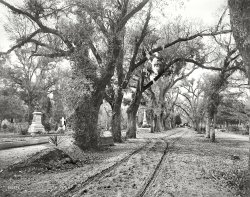
- Washington Accessories: 1922
- ... well as the coping surrounding lot will be granite stucco. Trees on the property will be preserved in the development, lawns and shrubbery ... Posted by Dave - 09/04/2012 - 12:05pm -
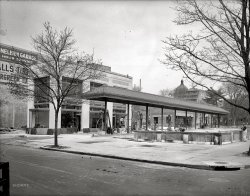
- Avenue of Oaks: 1938
- 1938. "Boone Hall, avenue of trees, Mount Pleasant vicinity, Charleston County, South Carolina." 8x10 ... View Larger Map
It's got moss appeal The trees to seem to be saying "Hurry, this way out!"
Not much has changed ... Posted by Dave - 02/08/2014 - 11:39am -
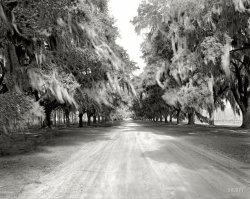
- A Summer Place: 1910
- ... lake shore with a broad expanse of lawn and towering fir trees to provide ample shade and cooling breezes during the hottest hours of ... Posted by Dave - 05/18/2014 - 12:38am -
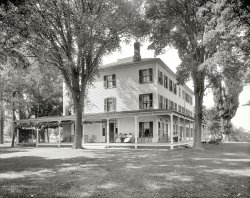
- Chicago Beach: 1900
- ... View full size.
Open windows? The bare trees and warm coats on the lads out front suggest it's a cold day - yet there ... Posted by Dave - 05/25/2017 - 8:01pm -
